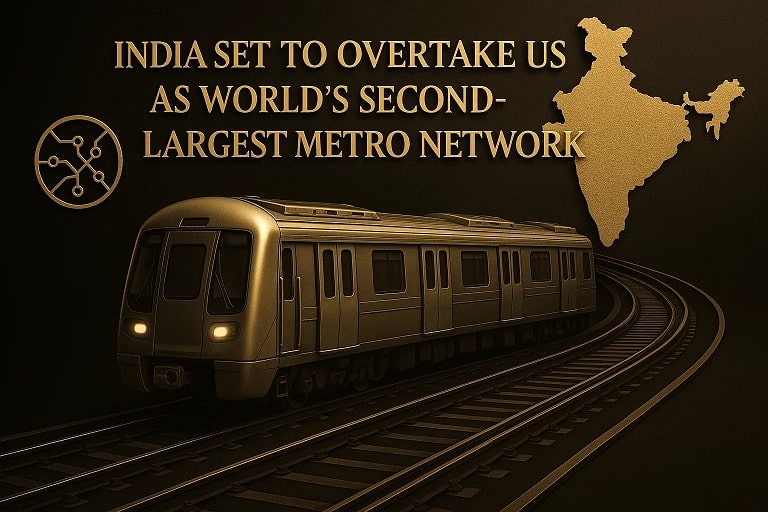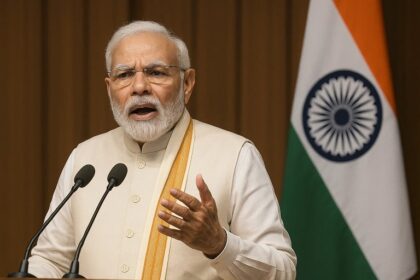India Set to Overtake US as World’s Second-Largest Metro Network: A New Era of Urban Mobility
India is poised to surpass the United States to become the world’s second-largest metro rail network by 2027, trailing only China, according to Union Housing and Urban Affairs Minister Manohar Lal Khattar. Speaking at the Urban Conclave in Kerala on September 12, 2025, Khattar announced that India’s metro network, currently spanning 1,065 kilometers across 24 cities, is set to expand by an additional 955 kilometers through five major projects in the pipeline. This ambitious growth is expected to push India’s network beyond the US’s 1,400 kilometers, marking a significant milestone in urban infrastructure development. This comprehensive article explores the details of India’s metro expansion, recent developments, historical context, economic and social impacts, future prospects, and more, providing a complete overview of this transformative journey.
Why India’s Metro Expansion Is a Global Game-Changer
India’s rapid urbanization, with 30% of its population living in urban areas in 2025 and projected to reach 50% by 2057, has driven the need for robust public transportation systems. The metro rail network, recognized for its efficiency, sustainability, and capacity to reduce traffic congestion, is a cornerstone of India’s urban development strategy. The planned expansion not only enhances connectivity but also positions India as a global leader in infrastructure, aligning with the government’s vision of a “Viksit Bharat” (Developed India) by 2047. With projects like Bengaluru Metro Phase-3 and Pune Metro’s southern extension, India is leveraging cutting-edge technology and international partnerships to redefine urban mobility.
Key Highlights of India’s Metro Expansion
- Current Network: 1,065 km operational across 24 cities, ranking India third globally after China (8,000+ km) and the US (1,400 km).
- Upcoming Projects: Five projects adding 955 km, including Bengaluru Phase-3, Thane Internal Ring Road, and Pune Metro extensions.
- Timeline: India expected to overtake the US by 2027, with full project completion by 2028.
- Economic Impact: Projected to create 2 million jobs and contribute $50 billion to GDP by 2030.
Latest Developments and News
Union Minister Khattar’s Announcement on September 12, 2025
At the two-day Urban Conclave organized by Kerala’s Local Self-Government Department, Manohar Lal Khattar highlighted India’s metro ambitions, stating, “Metro services are operational in 24 cities covering 1,065 km. Soon, we will surpass the US, which has 1,400 km.” The event, focused on drafting Kerala’s urban policy, underscored the role of metro systems in sustainable urban growth. Khattar also emphasized e-mobility, announcing an order for 10,000 new electric buses to complement metro expansion.
Cabinet Approvals on August 16, 2025
The Union Cabinet approved three major metro projects worth ₹30,765 crore on August 16, 2025, for Bengaluru, Pune, and Thane. These projects, covering 1,018 km under construction, mark a significant step toward overtaking the US. The approvals have boosted investor confidence, with infrastructure stocks gaining 5% in August 2025.
Industry and State Government Reactions
On September 10, 2025, the Ministry of Housing and Urban Affairs reported that metro construction has accelerated from 600 meters per month before 2014 to 6 kilometers per month today, reflecting technological advancements. State governments, including Maharashtra and Karnataka, have pledged faster land acquisition to meet deadlines, with Bengaluru Metro Phase-3 set to begin operations by 2027.
India’s Metro Journey
India’s metro rail history began with the Kolkata Metro in 1984, the first in South Asia. The Delhi Metro, launched in 2002 under the Atal Bihari Vajpayee government, set a global benchmark for efficiency and scalability. From just 248 km across five cities in 2014, the network has grown to 1,065 km across 24 cities by 2025, driven by central and state government collaboration. The introduction of indigenous coach manufacturing, with over 1,000 coaches produced in the last five years, has reduced costs and enhanced self-reliance.
Timeline of India’s Metro Milestones
Year | Event | Impact |
|---|---|---|
| 1984 | Kolkata Metro Launched | India’s first metro, covering 3.4 km. |
| 2002 | Delhi Metro Begins Operations | Set global standards for urban transit. |
| 2014 | Metro Network at 248 km | Operational in five cities. |
| 2024 | Network Reaches 973 km | Expanded to 23 cities. |
| 2025 | 1,065 km Across 24 Cities | Five projects approved to surpass US by 2027. |
Economic and Social Impacts
Job Creation and Economic Growth
The metro expansion is expected to create 2 million direct and indirect jobs by 2030, spanning construction, engineering, and operations. The projects will contribute $50 billion to India’s GDP, driven by infrastructure investments and increased urban productivity. Local economies in cities like Bengaluru, Pune, and Thane will benefit from enhanced connectivity, boosting retail and real estate sectors.
Consumer and Environmental Benefits
Metro systems reduce urban congestion by 20-30% and cut carbon emissions, supporting India’s net-zero goals. Affordable fares, starting at ₹10, make metros accessible to millions, improving quality of life for daily commuters. The integration of e-buses further promotes sustainable mobility.
Challenges and Risks
High project costs, averaging ₹407 crore per kilometer, pose fiscal challenges, with delays risking cost escalations. Land acquisition disputes and global supply chain issues, such as semiconductor shortages, could slow progress. Ensuring state-central coordination remains critical to meeting the 2027 target.
Future Scopes: India’s Vision for Urban Mobility
Global Leadership by 2030
By 2030, India’s metro network could exceed 2,500 km, challenging China’s dominance. The Regional Rapid Transit System (RRTS), connecting urban centers, will complement metro growth, with projects like Delhi-Meerut RRTS set to expand. Investments in AI-driven traffic management and green technologies will enhance efficiency.
Technological Advancements
India is adopting driverless metro systems, with Delhi Metro planning fully automated lines by 2028. Indigenous manufacturing of metro coaches, supported by four state-of-the-art facilities, will reduce costs and boost exports, targeting $5 billion by 2030.
Policy and Infrastructure Support
The government’s ₹1 lakh crore infrastructure budget for 2026-30 will fund metro expansions and smart city projects. Public-private partnerships (PPPs) and international loans from Japan and the Asian Development Bank will ensure financial sustainability.
Potential Scenarios for 2030
- Optimistic: India becomes second-largest metro network by 2027, reaching 3,000 km by 2030.
- Moderate: Steady growth to 2,500 km, with minor delays in smaller cities.
- Pessimistic: Delays push US overtake to 2029, with 2,000 km operational.
Frequently Asked Questions (FAQs)
When will India overtake the US in metro network size?
India is projected to surpass the US’s 1,400 km by 2027, with its current 1,065 km expanding by 955 km.
Which cities are part of India’s metro expansion?
The network spans 24 cities, including Delhi, Bengaluru, Pune, Thane, and Kolkata, with new projects in Jaipur, Patna, and Lucknow.
How many jobs will the metro expansion create?
It is expected to generate 2 million direct and indirect jobs by 2030, in construction, operations, and supply chains.
What is the cost of building metro systems in India?
The average cost is ₹407 crore per kilometer, varying by underground or elevated design.
How do metro systems benefit the environment?
They reduce urban congestion by 20-30% and cut carbon emissions, supporting sustainable urban growth.
What challenges could delay the metro expansion?
Land acquisition disputes, high costs, and supply chain issues like semiconductor shortages pose risks.
India’s Metro Leap: A Global Benchmark
India’s meteoric rise to become the world’s second-largest metro network by 2027 marks a transformative moment in urban mobility. With 1,065 km operational and 955 km in the pipeline, the country is redefining connectivity, sustainability, and economic growth. As metro systems expand, India is not just building tracks but paving the way for a developed, inclusive future.
Key Takeaways
- Global Milestone: India to overtake US by 2027 with 2,020 km of metro lines.
- Economic Boost: 2 million jobs and $50 billion GDP contribution by 2030.
- Sustainable Mobility: Reduced congestion and emissions through metros and e-buses.
- Policy Drive: Government support and indigenous manufacturing fuel growth.












